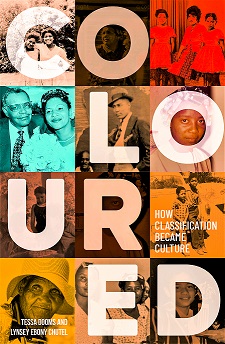BUT Jan van Riebeeck, he made the Coloured; not Black enough, not White enough; do Coloured people even have a culture?
On and on and on the punchlines, phrases and stereotypes go amongst South Africa’s other racial/colour demographics regarding the other officially recognized population group: The Coloureds.
At the onset of the South African Spring, a book which resonates with my own – and that of most of the country’s citizens – lived experience, was included amongst the monthly wish list of reads I have to peruse through for reviewing.
Simply titled Coloured, it resonates with me from various angles, from its duo of authors having been raised in a place of affinity to my existence, namely, Eldorado Park, to their largely expounding on the neighbourhood, it’s people and history, etc.
Having been raised in Pimville, Soweto for most of my formative years, Tessa Dooms and Linsey Ebony Chutel – the hitherto mentioned authors – are literally neighbours only separated by the Soweto Country Club, either an intentional or unintentional physical barrier of apartheid’s Group Areas Act construct.
And some of the social barriers observed by their kind and Blacks such as myself residing across Union Road, form part of childhood memories still active upon one’s adult psyche: deeming it dangerous to venture into ‘their’ neighbourhood for fear of provoking beatings for merely being of a darker hue and, as Black kids, sitting in the front rows of San Souci bioscope in nearby Kliptown and Coloured peers occupying the vantage layout (back and upstairs seats) of the movie house, et cetera.
Dooms, a sociologist, recalls eliciting shock from a mainly African-American audience at an American university at her mention of the word ‘Coloured’ whilst delivering a presentation. Aghast at their reaction when she was merely pointing out to one of her country’s racial demographic – it dawned on her that the term was an insult steeped in hurtful history for them!
Alternating insightful narratives throughout the paperback’s chapters, both writers take the reader into diverse realms such as the unending intergenerational tribulations of hair grooming (with rollers and pantyhose) for girls and women such as Chutel who have ‘kroes hare’ (tightly curled hair) as opposed to straight flowing hair characteristic of her race’s phenotype; the analyzed disclaimer that Trevor Noah isn’t Coloured (with the comedian explaining off his light skin as stemming from albinism, to friends in his Soweto neighbourhood); a then young Cheryl Carolus’s family being accosted by gatekeepers of apartheid whilst picnicking on a ‘Whites-only’ Western Cape beach, and threatened with arrest; 2007 Rugby World Cup-winning Springbok, Ashwin Willemse, angrily storming off a live television studio in reaction to a slur of being referred to as a ‘quota player’; schoolboy, Leaveil Ward, leaving his Heidedal community upon earning a scholarship to prestigious Grey College and thereafter proclaiming, “I’m part of my community, but I’m not proud of my community” – once the lure of the white side of Bloemfontein enticed him to the point of rejecting his native one, etc.
Yet Coloured – subtitled, How Classification Became Culture – isn’t only about the negative miasma of a particular group continuing to exist in a segregation scarred country, for it also acknowledges high notes and celebrates protagonists of its purview: in a segment titled Huiskos, narrated by Chutel, she delves into the delights of home food such as tomato smoortjies, groenboontjies, bobotie, Gatsby, koeksusters, melktert (with a laminated copy of her Aunty Ruth’s dessert recipe inserted in the book), etc., prepared from the kitchens of households stretching from Noordgesig, Eersterus, Wentworth to Sydenham, Koffiefontein, Lavender Hill, etc. – to fuse into wholesomeness whose ingredients and recipes are an amalgam of shared histories as opposed to being singularly identified as Coloured cuisine!
A section titled Musical Roots describes the role music permeate in Coloured communities with Dooms mentioning her singing on church stages of Riverlea, Newclare, Noordgesig and Eldos as a three-year-old.
Between touching on community participation in ‘Putting on the Hits’ singing completion, she also mentions the achievements of fellow Eldorado Park resident, Zarcia Zacheus, a well-known recording singer – stretching on to expounding on the Kaapse Klopse tradition of Tweede Nuwe Jaar parade, et cetera.
Described in the intro as a book for Coloured people by Coloured people – with the rider, if you are not a Coloured South African, this book is for you too – Coloured’s cover is splashed with a kaleidoscopic photomontage of imagery from the authors’ family albums whilst the monochromatic images located within the tome’s pages evoke nostalgia familiar to a community’s fabric.
Distributed by Jonathan Ball Publishers, Coloured is available at leading retailers countrywide and is priced at R270.

